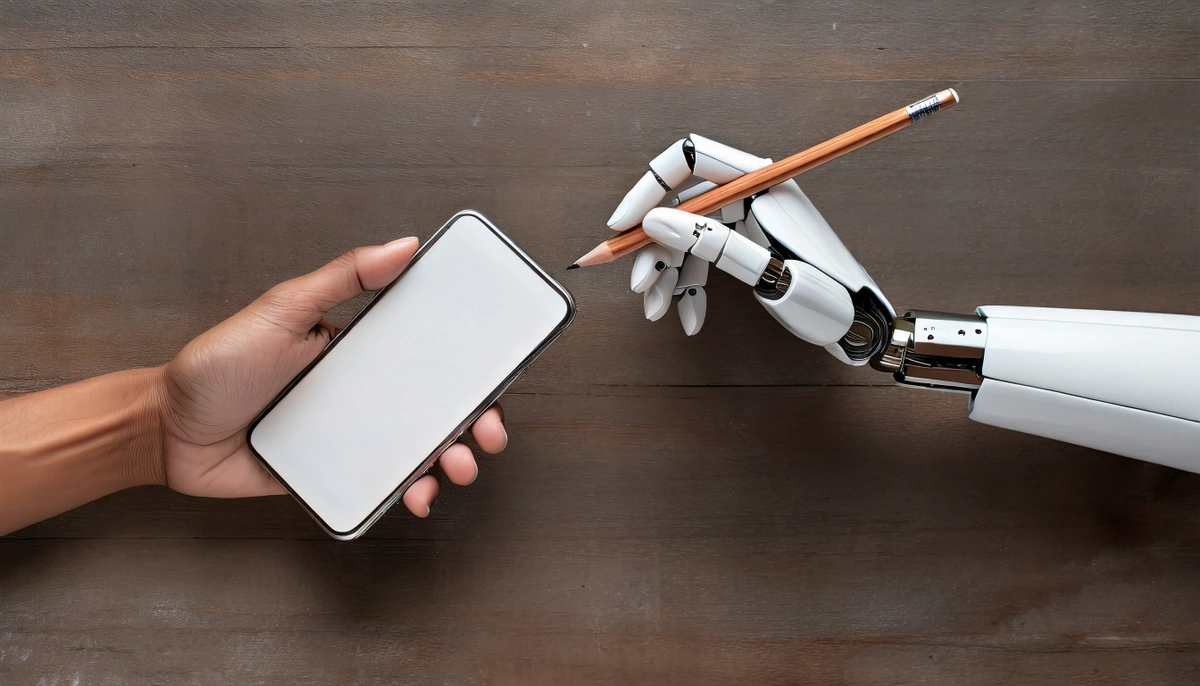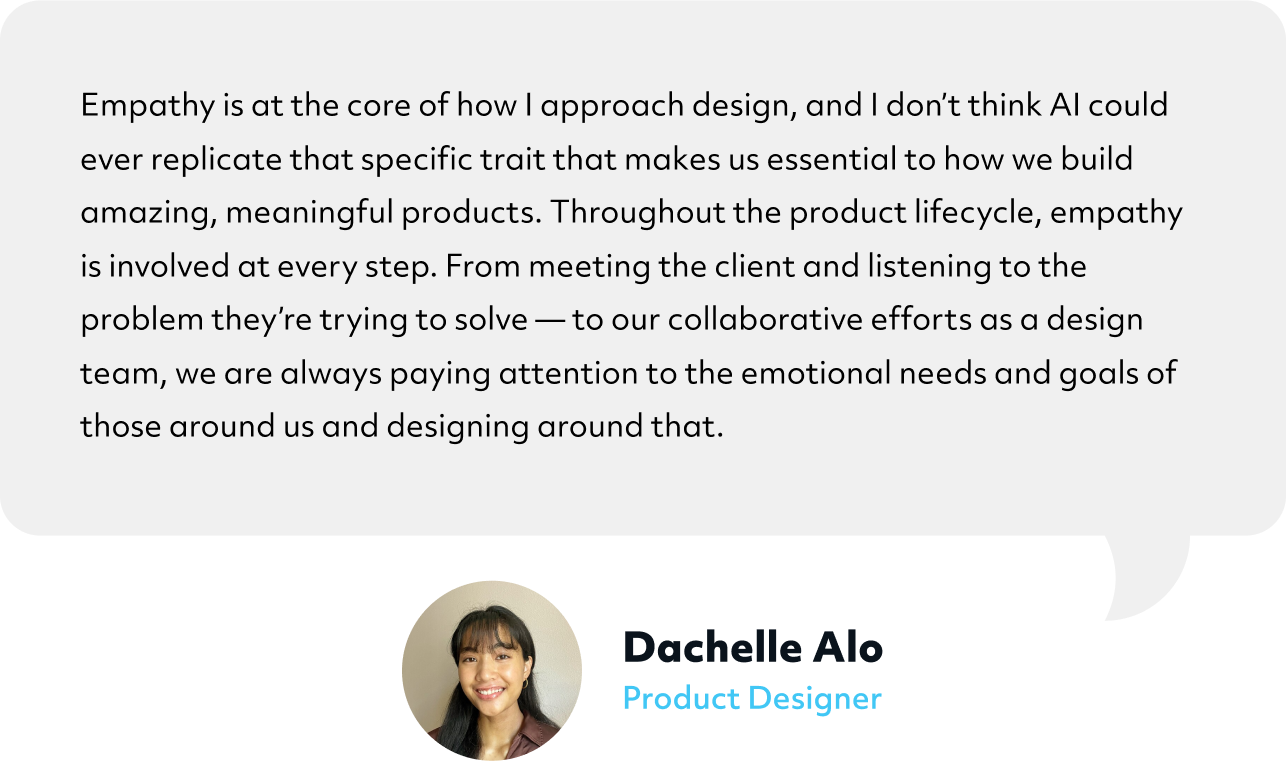How AI is Revolutionizing the Creative Process for UX/UI Designers

From Nvidia to OpenAI, artificial intelligence is transforming the way we create and utilize digital products. With the emerging technology powering the way we function daily and disrupting the digital landscape, the impact of AI only continues to grow and develop a deeper integration into our work and personal lives.
What is artificial intelligence?
Artificial intelligence, or AI, is the ability of machines or software to perform tasks that normally require human intelligence, such as understanding language, recognizing images, solving problems, or learning from data. AI has been around for a while and is present in almost every digital product we use, but the emergence of big AI players like Open AI, Google Bard, Adobe Firefly, and Midjourney have sensationalized the term "AI" itself and its capabilities, generating discussions on how much of it we use in our personal and work lives, and how much we actually should.
With a few nicknames given to the birth of AI in UX/UI design (AI-Driven Design, Design Intelligence, chatgptdesign), the reality of using machine learning and algorithmic-based technology to build and scale digital products provides major opportunities for development teams to capitalize on, mainly related to productivity and cost-efficiency. But one persistent challenge remains: how to balance human and machine input. AI can generate ideas, designs, and code, but it may not always align with the vision, goals, and values of the user. When a designer’s role is to create digital experiences that engage and retain users, the design process- one of the most critical elements of a digital product’s life cycle journey- becomes inevitably subject to the impacts and workings of artificial intelligence.
So how much does AI affect the creative process of developing an app? What challenges and opportunities does AI present teams now and in the future? In this blog post, we explore these questions and delve into the nuances of incorporating AI into UX/UI design, and why the human element of this process remains critical and indispensable.
AI tools for the UX/UI Design process
AI can enhance the user experience and provide personalized solutions through a number of processes like machine learning, natural language processing, computer vision, and speech recognition technology. Industry experts have highlighted that AI-driven design will be a key tool for designers and has already began to show promise in generating revenue and improving customer experience metrics (uxdesign, 2023). But it’s important to note that the purpose of UX design still requires human input, no matter how many software programs or tools you use in the process. You’re developing products for humans, which means you’ll need to be able to understand their needs, interests, behaviors, and motivations at the end of the day. Simply put: empathy, collaboration and creativity are outputs AI cannot replicate.
Building and scaling apps requires an in-depth understanding of a client’s needs and interests for the digital product they’re coming to you with. In the past, developers have had to conduct time-consuming tasks for accomplishing this. Thankfully, AI has provided new ways to cut down on that time, with more precision and data reporting at each stage of the design process.
AI has done that in a number of ways:
Research
AI can help us propose new questions of inquiry when beginning work for a client and help us accomplish a variety of research-based tasks. One of the biggest advantages here: taking on the learning curve. AI-supported research allows you to learn more about the industries and technologies you may not be familiar with. Although you won’t be considered a SME anytime soon, building a solid understanding of audiences, markets, and industries with these tools provides a team with the advantage of having been exposed to concepts and practices that’ll help with client discussions. It’ll require fact-checking because AI may not always produce accurate results, but it’ll enhance your understanding of the market your client is attempting to provide a solution for.
Analytics
AI-driven analytics provide more accurate data on consumer behaviors and pain points in the early stages of product development (Medium, 2023). One of the first steps in developing an app is to conceptualize an idea that solves a problem or fulfills a need for a target audience. AI supports this by providing robust data analysis, market research, predictive behavior analytics, and user feedback through insights reporting. Designers can leverage this to gain a more comprehensive understanding of the client’s vision using data-driven decision making. For example, analytics can help identify gaps in the existing market, generate new ideas based on user preferences and market spending patterns, or suggest features and functionalities that would increase user engagement time- all at a fraction of the time.
Automation
Operationally, AI can be used to streamline workflow processes, such as building user flow templates. Something as simple as searching “create a user flow for a user onboarding process” can help designers to identify any edge cases or fill in missing steps that are important to the user experience. AI also helps cut down on tasks like usability testing and prototyping which can be time-consuming, especially during the initial phase of product development. But new AI tools let you build design variations faster based on user preferences and integrated data. Our Senior Product Designer, Bekah Hanson explains the impact on prototyping:
The benefits that AI-powered tools provide designers will continue to evolve over time, and designers should use them to optimize their workflow and creative output. Here, we mention a few tools we’re fans of:
-
Khroma: for generating custom color schemes for designing
-
Firefly: for generating images
-
ChatGPT4: for obtaining industry-specific knowledge and concepts; their latest update includes newer capabilities like internet search and image generation with Dall-E
-
Figma: for collaborative efforts in the creative phase; their new partnership with Diagram uses UI AI to help generate designs and glyphs
-
Data.ai: for combining consumer and market data for insight reporting
-
Userlytics: for conducting remote user research and user testing
-
Superpowered.AI: for capturing meeting notes and organizing tasks for your team
The Limitations of AI
As advantageous as the technology is, AI also presents a variety of challenges throughout the design process.
The Human-Centered Approach
AI tools are useful and cost-effective for generating content, analyzing data, optimizing performance, and automating workflows, but they cannot replace the human-centered design process that is essential for creating engaging and effective digital products. Human-centered design involves understanding the needs, goals, and emotions of the users, and designing solutions that are tailored to those behaviors and psychological needs. Using only AI-powered tools in your design process can ultimately result in digital products that are generic, impersonal, or irrelevant to the users- setting your product up for market failure. Dachelle Alo, one of our Product Designers, stresses the importance of using concepts like empathy throughout that human-centered design process to ensure success:

Accuracy & Stability
Additionally, using AI to generate code or design still requires supervision and fact-checking, because output models make mistakes too. AI has also prompted ethical considerations on the training inputs and model outputs. This can include biases or inaccurate presumptions about demographics you might be interested in reaching with your product during the research and testing phase. And because data collection is limited for some AI learning models (and will continue as data privacy measures have increased in popularity among the public), many of these tools won’t always have comprehensive access to consumer data. Adding to the list of ethical considerations, the rise of AI-powered tools will also present concerns for user safety, if they aren’t developed properly to mitigate potential cyber attacks and securely handle personal data.
Maintenance & Upkeeping
Maintaining a digital product can be hard without a basic understanding of UX/UI design and can become more expensive to do so over time. Hiring a team with experience in UX/UI design and AI tools allows you to leverage their creativity and tacit knowledge, as well as feedback from data, to create and sustainably manage your digital products. For example, someone who wants to create a music streaming app can use AI tools to generate playlists, recommend songs, and analyze user streaming behavior, but they still need to design the app's interface, features, and branding based on their own unique vision and their desired market's needs. AI won't always give you a range of options, and when it does, they might be not as valuable as a human's contributions. Think of it like this: AI could give you directions to work, but might take you through the long way like the freeway, when you might already have a route that lets you avoid traffic and get there quicker. Managing a digital product is like that because AI doesn’t know the best practices for human-centered design that someone with years of experience in UX/UI design might know. Would you trust a doctor with a degree from ChatGPT? We certainly hope not but to each their own!
Finishing (Human) Touches
Weighing opportunities and challenges of using AI, it's undeniable that AI is revolutionizing the way we build and scale digital products. The technology itself still has ways to go as it becomes regulated and trained more accurately, but it provides plenty of opportunities for development teams to take advantage of. For UX/UI design teams, this means embracing AI in ways that streamline project workflows and get more output for bringing a clients’ vision to life. By doing this, designers maintain a competitive edge to deliver more meaningful products to clients and their users using tools that automate traditionally time-consuming processes and leveraging data to make critical design decisions.
And design teams shouldn’t be discouraged by what the future of UX/UI design holds either. AI can scan data faster and quicker than humanly possible, but it can’t understand the emotions and cultural nuances that motivate people to buy a product or use a service. That remains our job as designers, developers, and most importantly, as innovators of digital products that cater to the human experience. That advantage over AI will continue to be indispensable.
Read more academy articles →